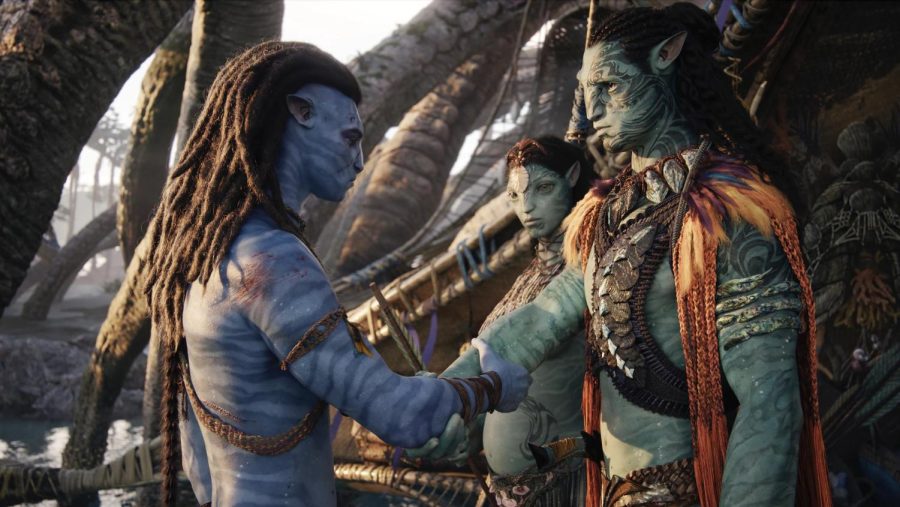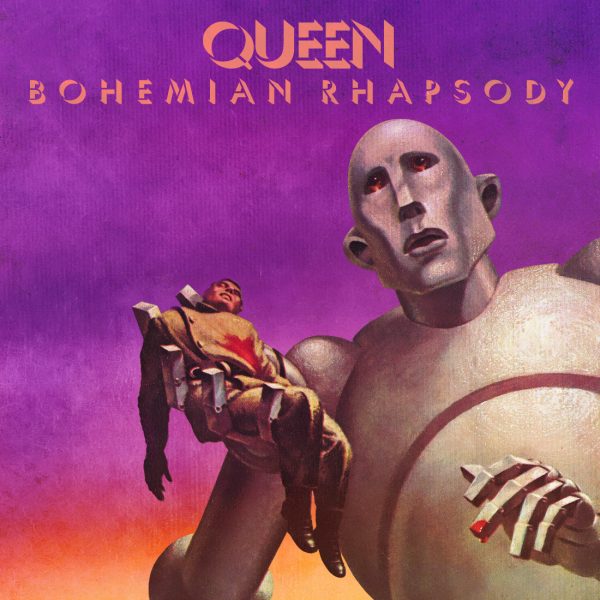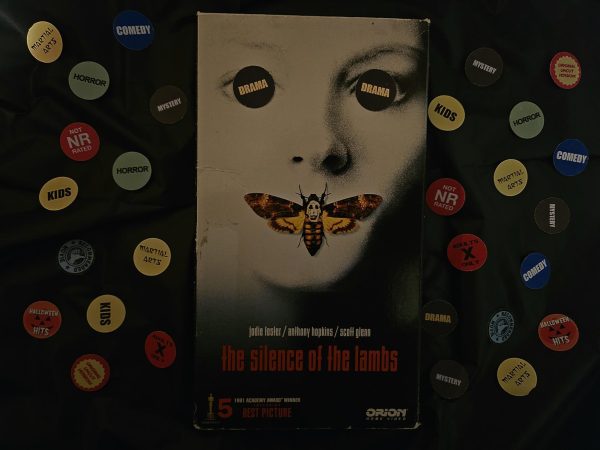Avatar Imperialism and Appropriation Controversies
Jake Sully shaking hands with the Chief of the Metkayina people (Used with permission from Disney)
After 13 years of waiting the second Avatar movie, “The Way of Water,” came out on December 16th, 2022. Many people around the nation were anticipating another “movie of the year” when the film released. However, many were not impressed.
Many of the films’ critics considered the movie offensive, a form of appropriation, and inaccurate. News articles have been reporting on the issues surrounding the movie, saying Indigenous people have taken an uproar to the movie’s theme of white saviorism and cultural misinterpretation.

In “Avatar,” the Indigenous people of Pandora are Na’Vi. The film features tribes called the Omaticaya and Metkayina tribes, which are based on the real tribes of the Nilotic and the Maori peoples. The Nilotic people of Africa were the inspiration for the Omaticaya tribe, tree-dwellers, because of their sharing of lore and familial ways. The Metkayina, water-dwellers, are based on the Maori tribe for their culture and Indigenous Polynesian background.
Overall Na’Vi philosophy, beliefs, and even the blue pigment is based on Hindu deities. They are based on Gods like Vishnu, who are advocates of preservation, protection, sustainability of the land, and its people as a whole. Vishnu is a mediator of disagreements and protects morals whether that of the same God-like people or human; all characteristics much like that of the Na’Vi on Pandora. James Cameron stated in many interviews that he has a love for the spiritual connections in Hindu religion and used ideas from it to create his movie.
When it comes to the presentation of the Na’Vi characters, their skin pattern, colors, and hair are different per the clan environment. The Omaticaya are dark blue with little white spots like the night sky and their hair is dreaded. The Metkayina are a lighter color like cyan with waves through their skin to blend-in with the water they live in, their hair is fluffy and braided.
Many of the critics regarding the Metkayina looks and characters disagree with how the Avatars are made, especially for being based on the Maori tribe. Their hair in particular is partially braided when traditional Polynesian hair is fluffy and rarely in braids.
A student of Polynesian decent at Central Kitsap High School, Kai Todd, said that “Polynesians don’t, we don’t use braids.”
Traditionally, buns and natural hairstyles are worn for simplicity and hair is rarely cut because of the belief that mana, a spiritual connection, is linked through the hair and mind. If they could have redirected the movie they would have,

“Definitely given them Polynesian hair, like bigger, puffy or not in braids,” said Todd.
In the first Avatar, someone made a point in an interview with James Cameron that the braids are created to hide the neural queue tail that they have on their heads. Although, the Metkayina in the second movie have braids in parts of their hair and the rest is puffy and wavy like that of traditional Maori.
“I really liked their tattoos,” said Todd.
In the movie the producers paid close attention to details like this. They got the tattoos fairly accurate, especially the sacred chin tattoo called the Ta Moko or Moko Kauae. This addition to the Metkayina look really ties in the Maori culture, representing their heritage.
A student from Central Kitsap High School, from Native American decent, Emri Brien feels there were good attributes and bad ones that were just missed opportunities to improve;
“I think bringing in Maori people would be a better representation to really embody the people to maybe not just act, they don’t have to act if they don’t want to, but bringing in Maori people to further educate the producers and the actors on how to do stuff… ask how certain things are done,” said Brien.
There is another topic a critic reviewed, aside from the characteristics of the traditional tribes the clans in “Avatar” are based on, that the white savior narrative presented by Jake Sully. Sully is a white man who is one of the “sky people” from Earth looking to inhabit Pandora. Sully suffered a spinal injury and could not survive as a human anymore, so he transformed into his Avatar permanently. He double crossed humans and saved the clans from terror on Pandora. In the second movie, he leaves the Omaticaya Clan to join the Metkayina Clan for his family’s safety due to human soldiers re-invading Pandora. He then collectively saves the Metkayinas’ sacred land, animals, and people from poaching.
Critics are boycotting the CGI masterpiece and are unimpressed with the main character, a white man, being the constant savior of all the native people; comparing it to that of the American history when white men pillaged native land, relaying it as inappropriate that one of “them” should be the hero of the series thus far.

Overall, many critics find this movie to be a form of appropriation. For a professional view, a history teacher from Central Kitsap High School, who has an education in Social Studies and History was called for question. Although he has not seen the second Avatar movie, he has a good idea of what may be interpreted incorrectly.
When talking about the view of cultural appropriation, teacher Eric Randall said, “They were supposed to be playing aliens but aren’t supposed to be playing the tribal members in real life.”
This brought up the idea that they are a historical representation and characters in a fiction narrative.
“He (James Cameron) had to base the Na’Vi on something, and when he did, obviously…the only thing you could base it on would be, tribes or Indigenous groups that exist, and they live in that kind of state you’d imagine,” said Randall.
Randall spoke broadly on the many points the movie presents, especially when it came to the question of appropriation or appreciation. Many elements are brought together in the movie. There are extensive points and small ones.
“If somebody from one of those cultures is first offended by it I think that’s probably valid,” said Randall. “…As far as where the line is, with appropriation and appreciation?…that line can be kind of blurry.”
A worthy note to keep in mind though with such opinion is,
“Are they playing aliens? Or are they these groups? …if they’re playing aliens or playing nobody, right… if you look at it, there’s also sort of an anti war, anti imperialism message in the film…that’s based on like, real things that have happened historically… is it okay to ignore this element that might make you uneasy if you feel like the other broader element is stronger?… that’s what we’re all trying to figure out,” said Randall.
The way of water predominantly has bad reviews, but there are also things well done, aside social controversies. There are three more Avatar movies yet to come, the question is, can the movies redeem the past ones or will the controversies prevail?













